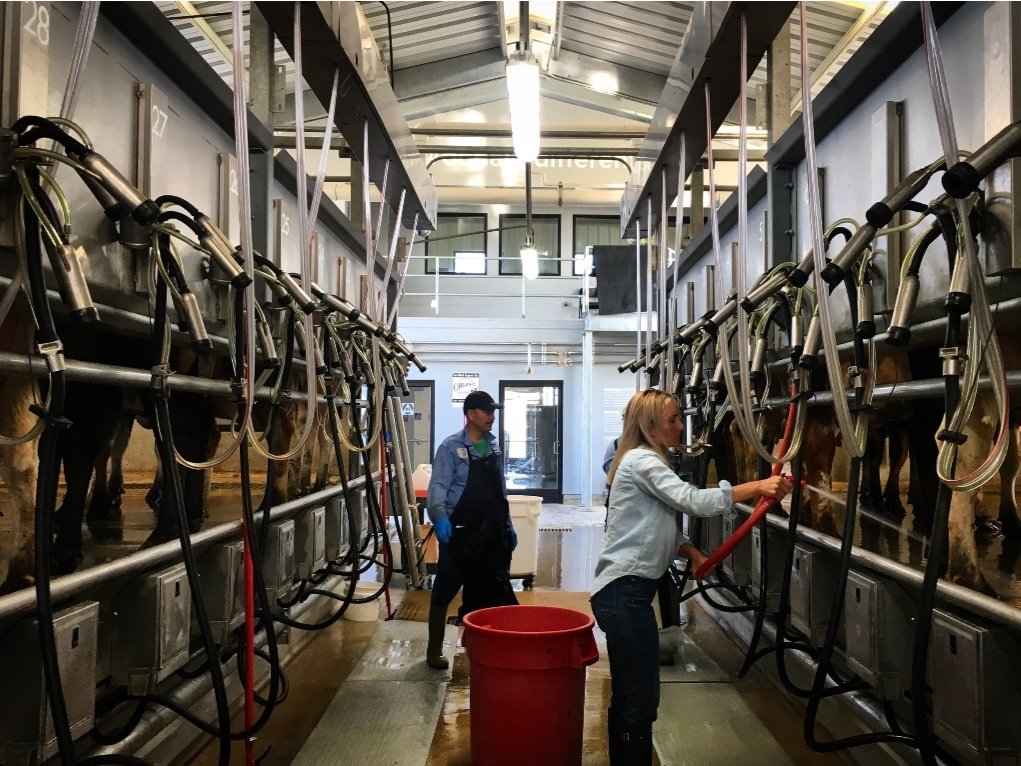Sanitization can be an important part of an overall cleaning process for raw milk equipment, bulk tanks, and bottles. This is because bacteria growth can occur in milking equipment during the time between milkings. These bacteria can contribute off flavors to the milk, shorten shelf-life, and in rare cases they can contribute to pathogenic illness when the raw milk is consumed. The use of a sanitizer can help by reducing the bacteria load in milking equipment.
Simple bucket milker systems and pipeline systems being used more than once per day may not need be sanitized prior to milking, and this can be confirmed with the use of bacterial tests. However, pipeline systems, and especially pipeline systems being used only once per day, may necessitate the use of a sanitizer rinse just prior to milking in order to lower the level of bacteria in these systems. Additionally, some states (such as Vermont) require that a sanitizer be used on milking equipment just before milking.
Bleach and chlorine-based sanitizers are readily available and widely used for milking equipment. However, when bleach or other chlorine-based sanitizers are used, special attention needs to be given to ensure that the amounts of sanitizer being used are carefully controlled.
Harmful By-Products from Chlorine Sanitizers
Although chlorine is quickly inactivated by contact with organic matter, chlorine is also known to create disinfection byproducts that can be toxic including trihalomethanes such as trichloromethane (i.e. chloroform). These toxic byproducts are formed when the acetoin, diacetyl, and other methyl ketones in milk react with chlorine [1].
Trihalomethanes and chloroform have been shown to increase the risk of cancer, liver damage, fertility problems, and miscarriages [2]. Chloroform is categorized by the USA Environmental Protection Agency as a Probable Human Carcinogen.
Harmful Chlorine Byproducts in Milk
Studies, including those shown below, have shown that when chlorine-based sanitizers are used in greater-than recommended amounts, there can be unhealthy levels of sanitizer residues and toxic byproducts in the milk.
Volatile Organic Compounds in Foods: A Five Year Study [3] – In this study, the highest levels of chloroform in foods in the USA were found in dairy products.
Chloroform in milk and dairy products B: Transfer of chloroform from cleaning and disinfection agents to dairy products via CIP [4] – This study found that the use of chlorine-based sanitizers in a Clean-In-Place (CIP) milking system can result in chloroform formation and contamination in the raw milk. Chloroform was also found to concentrate in the milkfat, and therefore the levels of chloroform in cream, butter, and cheese were greater than the amounts in fluid milk.
Evaluation of Trichloromethane formation in Cow’s milk from chlorine-based cleaning and disinfection agents [5] – This study found that “Increased chlorine concentration in the detergent and reduced rinse water volume resulted in increased TCM [trichloromethane] concentrations in milk, while the addition of chlorine to the rinse water also increased milk TCM.”
Strategy for the reduction of Trichloromethane residue levels in farm bulk milk [6] – This study found that the ‘first milk’ that was collected in a milk pipeline system was likely to have higher concentrations of chloroform than milk which was collected subsequently. Increasing the volume of rinse water in the pipeline resulted in a decrease in the amount of chloroform in the milk. When chlorine-based sanitizers were used in recommended amounts, the total level of chloroform was found to be below the acceptable limit.
Acceptable Limit Standards
The USA Environmental Protection Agency sets an acceptable limit for chloroform and other trihalomethanes in drinking water at 0.06-0.08 mg/L [7]. The European Union (EU) sets the acceptable limit for chloroform and other trihalomethanes in drinking water at 0.1 mg ⁄kg [5]. Both of these standards are well below the concentration that would be considered carcinogenic.
The USA and EU have not published regulations on the acceptable limits for chloroform and other trihalomethanes in food. However, in Germany 0.1 mg/kg has been set as the acceptable limit for chloroform and trihalomethanes in food, and target levels of <0.03mg/kg for butter and <0.002 mg ⁄kg for milk have been recommended [5].





